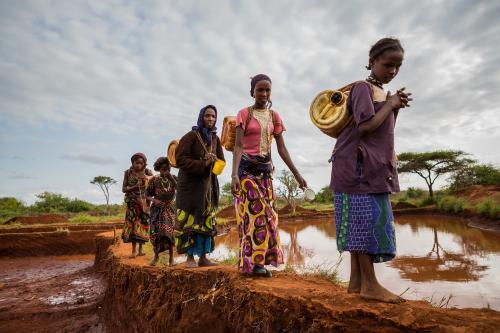On April 10, the World Bank released the 11th edition of its South Africa Economic Update, with a special section of the report focusing on jobs and inequality in South Africa. The report highlights the current dynamics of inequality in South Africa, identifies key determinants, and presents policy options that can help reduce inequality.
According to the report, South Africa is one of the most unequal countries, with the highest Gini coefficient in the world (among countries where data is available), with recent interesting trends. Panel A in Figure 2.4 presents consumption inequality within South Africa. Notably, consumption grew fastest for the middle class, leading to greater consumption inequality between the poor and middle class but lower inequality between the middle class and rich. Overall, consumption inequality declined slightly in South Africa during the period 2006-2015.
Similarly, the share of income from work grew for those above the 40th percentile but fell for those in the bottom 40th, highlighting continued poor access to jobs and slowing growth in grants due to fiscal constraints for the national government (Panel B).
A key finding of the report is that the labor market in South Africa is central to reducing inequality. The share of inequality explained by education and employment has grown between 2006 and 2015, eclipsing race—a historically important factor in explaining inequality (Panel A, Figure 2.5). In South Africa, skilled workers earn five times as much as unskilled workers, representing a larger skills premium than in most countries (Table 2.2). The rising wage inequality, as shown in Panel B of Figure 2.5, highlights the mismatch between demand and supply for skilled labor.
 The report highlights several policy areas where interventions would support inequality reduction. Reducing the skills gap through improved access to education can help reduce wage inequities in the long term. Bringing in high-skill workers from outside South Africa in the interim can help those industries grow and create more jobs. Interventions to improve property rights and more equitably distribute land and assets can help reduce wealth inequities. Addressing inefficiencies at state-owned enterprises, which reduce the economy’s competitiveness and increasing integration into regional and global value chains, can help the economy grow. Finally, the report highlights the need to address challenges associated with South Africans living far from their jobs and the need to help historically underserved communities.
The report highlights several policy areas where interventions would support inequality reduction. Reducing the skills gap through improved access to education can help reduce wage inequities in the long term. Bringing in high-skill workers from outside South Africa in the interim can help those industries grow and create more jobs. Interventions to improve property rights and more equitably distribute land and assets can help reduce wealth inequities. Addressing inefficiencies at state-owned enterprises, which reduce the economy’s competitiveness and increasing integration into regional and global value chains, can help the economy grow. Finally, the report highlights the need to address challenges associated with South Africans living far from their jobs and the need to help historically underserved communities.






Commentary
Figures of the week: Labor market and inequality in South Africa
April 18, 2018